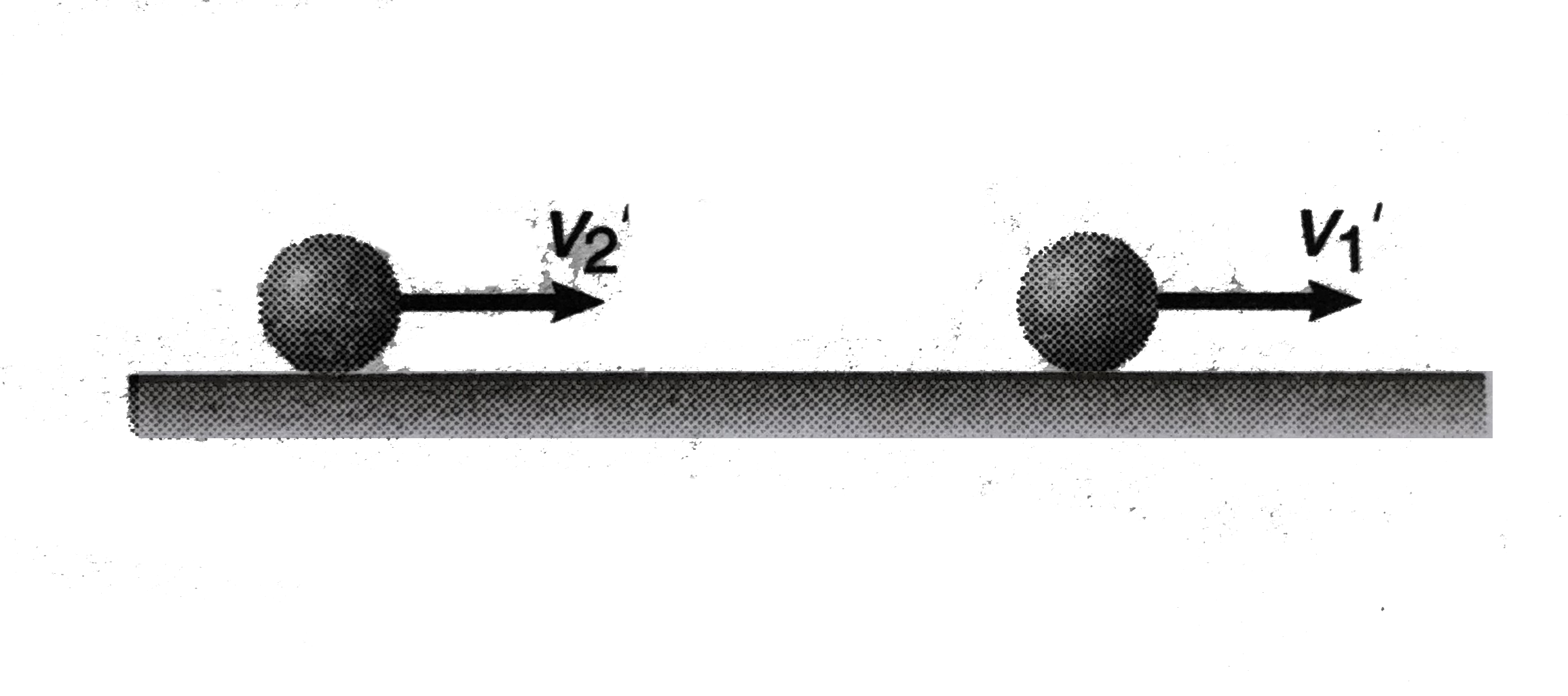A neutron makes a head-on elastic collision with a stationary deuteron. The fraction energy loss of the neutron in the collision is
To solve the problem of finding the fraction of energy loss of a neutron in a head-on elastic collision with a stationary deuteron, we can follow these steps:
Step 1: Understand the masses involved
- Let the mass of the neutron be m.
- The mass of the deuteron (which consists of one proton and one neutron) is 2m.
Step 2: Set up the initial conditions
- The neutron is moving with an initial velocity u.
- The deuteron is stationary, so its initial velocity is 0.
- The initial kinetic energy (KE) of the neutron is given by:
KEinitial=12mu2
Step 3: Use conservation of momentum
- The total momentum before the collision is:
Pinitial=mu+0=mu
- Let v1 be the final velocity of the neutron and v2 be the final velocity of the deuteron after the collision.
- By conservation of momentum:
mu=mv1+2mv2
Simplifying gives:
u=v1+2v2(1)
Step 4: Use conservation of kinetic energy
- The total kinetic energy after the collision is:
KEfinal=12mv21+12(2m)v22=12mv21+mv22
- By conservation of kinetic energy:
12mu2=12mv21+mv22
Dividing through by 12m gives:
u2=v21+2v22(2)
Step 5: Solve the equations
- From equation (1), we can express v1 in terms of v2:
v1=u−2v2
- Substitute v1 into equation (2):
u2=(u−2v2)2+2v22
Expanding gives:
u2=u2−4uv2+4v22+2v22
Simplifying leads to:
0=−4uv2+6v22
Factoring out v2:
v2(6v2−4u)=0
Thus, v2=2u3.
Step 6: Find v1
- Substitute v2 back into equation (1):
v1=u−2(2u3)=u−4u3=−u3
Step 7: Calculate the final kinetic energy
- The final kinetic energy of the neutron is:
KEfinal=12mv21=12m(−u3)2=12mu29=mu218
Step 8: Calculate the fraction of energy loss
- The energy loss of the neutron is:
ΔKE=KEinitial−KEfinal=12mu2−mu218=9mu218−mu218=8mu218=4mu29
- The fraction of energy loss is:
Fraction of energy loss=ΔKEKEinitial=4mu2912mu2=49⋅21=89
Final Answer
The fraction of energy loss of the neutron in the collision is 89.
- Let the mass of the neutron be m.
- The mass of the deuteron (which consists of one proton and one neutron) is 2m.
- The neutron is moving with an initial velocity u.
- The deuteron is stationary, so its initial velocity is 0.
- The initial kinetic energy (KE) of the neutron is given by:
KEinitial=12mu2
- The total momentum before the collision is:
Pinitial=mu+0=mu
- Let v1 be the final velocity of the neutron and v2 be the final velocity of the deuteron after the collision.
- By conservation of momentum:
mu=mv1+2mv2
Simplifying gives:
u=v1+2v2(1)
- The total kinetic energy after the collision is:
KEfinal=12mv21+12(2m)v22=12mv21+mv22
- By conservation of kinetic energy:
12mu2=12mv21+mv22
Dividing through by 12m gives:
u2=v21+2v22(2)
- From equation (1), we can express v1 in terms of v2:
v1=u−2v2
- Substitute v1 into equation (2):
u2=(u−2v2)2+2v22
Expanding gives:
u2=u2−4uv2+4v22+2v22
Simplifying leads to:
0=−4uv2+6v22
Factoring out v2:
v2(6v2−4u)=0
Thus, v2=2u3.
- Substitute v2 back into equation (1):
v1=u−2(2u3)=u−4u3=−u3
- The final kinetic energy of the neutron is:
KEfinal=12mv21=12m(−u3)2=12mu29=mu218
- The energy loss of the neutron is:
ΔKE=KEinitial−KEfinal=12mu2−mu218=9mu218−mu218=8mu218=4mu29
- The fraction of energy loss is:
Fraction of energy loss=ΔKEKEinitial=4mu2912mu2=49⋅21=89
The fraction of energy loss of the neutron in the collision is 89.
Topper's Solved these Questions
Similar Questions
Knowledge Check
An elastic collision conserves
Akinetic energy but not momentumBmomentum but not kinetic energyCneither momentum nor kinetic energyDboth kinetic energy and momentum
A ball of mass m moving at a speed v makes a head on inelastic collision with an identical ball at rest. The kinetic energy of the balls after the collision is 34th of the original. Find the coefficient of restitution.


View SolutionA neutron collides elastically with an initially stationary deuteron. Find the fraction of the kinetic energy lost by the neutron in a head-on collision?
View SolutionParticle A makes a head on elastic collision with another stationary particle B. They fly apart in opposite directions with equal speeds. The mass ratio will be
View SolutionA sphere A moving with speed u and rotating With angular velocity ω makes a head-on elastic collision with an identical stationary sphere B. There is no friction between the surfaces of A and B. Choose the conrrect alternative(s). Disregard gravity.
View SolutionA particle of mass m moving with velocity v makes head-on elastic collision with a sationary particle of mass 2m. Kinetic energy lost by the lighter particle during period of deformation is
View SolutionA ball of mass m moving at a speed v makes a head-on collision with an identical ball at rest. The kinetic energy of the balls after the collision is three fourths of the original. Find the coefficient of restitution.
View SolutionA moving hydrogen atom makes a head on collision with a stationary hydrogen atom. Befor collision both atoms are in in ground state and after collision they move together. What is the minimum value of the kinetic energy of the moving hydrogen atom, such that one of the atoms reaches one of the excited state?
View Solution